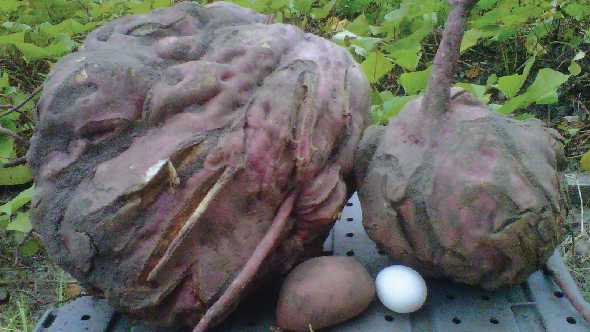Researchers Finding Biofuel Fits For Florida
Florida is one of the nation’s leaders in agriculture crop production and innovation. While efforts to start a biofuel industry have been exploratory, a research professor has a good idea what the best candidate crops are to fuel the new industry — and how to produce them sustainably. There are only a few crops that, in the short term, are suitable for biofuel feedstocks in Florida. The crops must be economical to grow; readily convertible to fuel using existing technology; tolerant to heat, drought, and excessive rain; and available as feedstocks year round.

The eTuber is a relatively easy crop to grow and creates large yields for biofuel conversion. Photo courtesy of UF/IFAS
According to University of Florida professor of agricultural and biological engineering, Dr. Brian Boman, the most promising crops for biofuel production are the eTuber (industrial sweet potato), sweet sorghum, and energybeets (non-edible sugar beets).
“These crops can be grown throughout South Florida and use biofuel processing technology that is ready now,” Boman says. “A crop rotation using the three crops can provide feedstocks for biofuels eleven months of the year.”
Boman is conducting research to evaluate two of the candidate crops’ efficacy for production in the state where year-long production is possible. He tested the eTuber and energybeets using a center-pivot irrigation system on a 24-acre experimental field located at the Indian River Research And Education Center near Fort Pierce.
The work was funded by the FDACS Office of Energy. Participating in the research project were Boman’s UF/IFAS colleagues Dr. Ann Wilkie, academic leader of the BioEnergy And Sustainable Technology Laboratory in Gainesville, and Dr. Edward “Gilly” Evans, assistant professor and associate director at the UF Tropical Research And Education Center in Homestead.
Better Than Corn
Both starch and sugar are used in the production of biofuels. Starch must be converted first to sugar and then formulated to fuel. However, sugar can be converted directly to biofuel.
The eTuber has 50% more dry matter than current leading varieties of sweet potatoes grown in Florida. And, as a result, offers a greatly increased ethanol producing potential. The crop’s starch also can be processed with current technology used to produce ethanol from corn. The crop tolerates heat, requires little irrigation, and produces up to five times more starch per acre than corn. Additionally, eTubers require less fertilizer and pesticides than do most other crops. They grow well in nutrient-poor sandy soils; recover well after drought and heat stress; are resistant to many nematodes and insect pests; don’t compete with food crops for prime land; and the processing waste is a high values protein product.
Energybeets produce simple sugars and ferment without the need for enzymes, which eliminates a step in ethanol production. Energybeets produce twice the amount of sugar per acre as corn. Additionally, stems and leaves may be sold as byproducts suitable for livestock feed products.
Perhaps the most valuable aspect for the crop is that it will tolerate below-freezing temperatures, which makes it a very attractive winter crop in Florida. Beets, however, will not produce well in Florida’s hot, humid summer seasons, and therefore must be harvested by early June. Both crops have the advantage of storing well in the ground and will continue to grow until harvested.
Florida Field Trials
The major objectives of the field trials are: experiments on planting density, rotation crops, fertilizer and irrigation rates, pest and disease control, and planting and harvest times.
Regarding plant processing, research objectives were: to optimize protocols for conversion into ethanol and byproducts, greenhouse gas analysis for eTuber from field and processing data, and testing syrup as a putative feedstock for algae, e. Coli, and yeast to make biodiesel, jet fuel, etc.
“We also are looking to develop a method of producing biogas using culled sweet potatoes, vines, and stillage through anaerobic digestion,” Boman says.
An economic analysis will include factors such as the costs for the crops’ production, economics for their conversion to ethanol and biofuels, a market potential analysis, and evaluation of the impact of commercialization of the energy crops and biofuel industry on economic development in Florida.
“We are focused on developing the information needed for growers who are considering an investment in the equipment necessary to produce energy crops,” he says. “Growers are not going to produce the crops until there is a market. We are a few years away from the industry taking off, but we need to be working on it now.”










